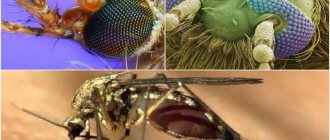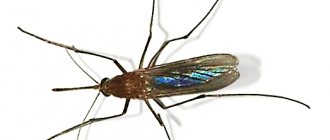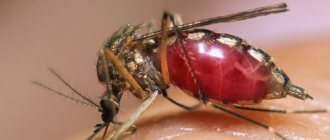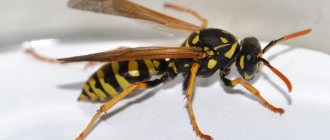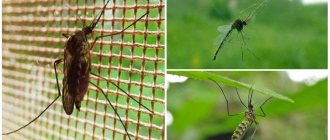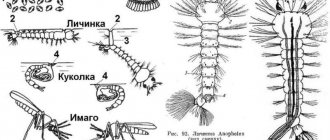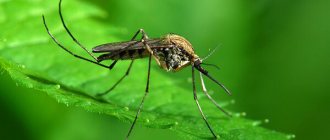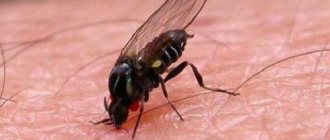Start and end of the season
For the full development and reproduction of these flying insects, a temperature of at least +100C and high humidity are required. Such conditions appear with the arrival of spring warmth. During this period, the hibernating female bloodsuckers wake up after winter, and their flight season begins.
Only female mosquitoes bite. To successfully lay eggs, they need human or animal blood rich in nutritional components. They digest it in the intestines and synthesize proteins necessary for the development of eggs. In this regard, insects are especially active after waking up.
Drunk on blood
With rising temperatures in the summer months and regular rains, the number of flying insects increases sharply, as the process of reproduction of bloodsuckers proceeds at an accelerated pace.
Mosquitoes disappear when conditions no longer meet the criteria for their life activity. With the arrival of autumn, as soon as it starts to get colder, the number of bloodsuckers decreases. The remaining individuals look for secluded places for wintering.
Mosquitoes will disappear when the first frosts arrive. This means their season is over.
Activity conditions and habitats
Interestingly, laboratory studies have revealed the following pattern: the activity of mosquitoes is determined by the ambient temperature. For example, at a temperature of 25 degrees, female mosquitoes of the species C. p. pipiens f. Molestus live up to 43 days, and males - up to 19 days (the life expectancy of males is always shorter). At 20 degrees, the lifespan of insects increases by an average of another 14 days. The studies carried out led to the conclusion that warm spring and cool summer are the most comfortable seasons for mosquito activity.
However, even in winter, in the absence of optimal conditions, mosquitoes find suitable habitats for themselves. And in hot and dry summers, these insects are found both in residential premises and shaded places (entrances, basements), and in nature in damp or marshy areas. It is in such places that the likelihood of becoming a victim of bloodsuckers is highest.
Bloodsuckers in the northern regions
Mosquitoes are widespread throughout Russia. But in Siberia they are found in large numbers. This is due to the fact that one of the important conditions for the life of bloodsuckers is high humidity. And in this region, when the sun warms the tundra in summer, many vast swamps form, where bloodsuckers live. In arid regions, mosquitoes die quickly, even if the air temperature is favorable for their life.
These flying insects, living in the northern regions, have, in the process of evolution, acquired resistance to low temperatures. With the arrival of cold weather, only males die, and fertilized females and larvae overwinter under ice and snow. During this period, they enter diapause, which leads to a slowdown in metabolic processes, resulting in resistance to unfavorable conditions.
Thief
- a person who systematically commits theft (in legal language - theft, theft).
Theft for a thief is a source of means for enrichment or simply for food. The thief, as well as his criminal activities - theft or theft, are the most ancient phenomena of human nature. In addition, there is a painful tendency to steal - kleptomania. Other meanings
In Russia, the term “thief” was applied to criminals who committed or intended state crimes.
In modern legal jargon, these are “crimes against state power, the foundations of the constitutional order, justice and the order of government.” And also against persons exercising power or personifying it (“Ise Majesty”, etc.) Treason was also called theft. But already by the 18th century, the term “thief” meant a criminal in general (the one carrying out the theft was called a “thief”). In the 20th century, the designation vor began to be used in criminal argot as a synonym for the term thief in law, that is, the “elite” of the criminal world, not necessarily associated with theft; in this sense, the adjective “vorovskoy” is used, vocabulary associated with asserting one’s own dignity over other “thieves” (thieves’ authority). A person who commits thefts is now called a “stealer” in criminal vocabulary. Types of thieves by specialization
- Pickpocket
- specializes in pickpocketing, distracting the victim's attention; often uses cutting to remove a wallet from a pocket or bag (slang: shchipach, shirmach, scribbler). - Burglar
- specializes in breaking into houses. - Window operator
- specializes in entering houses through windows (mainly at night). - Tenant
- specializes in watch theft. - Maraviher
- specializes in thefts in hotels, as well as social events. - Cranberry
- specializes in stealing icons and jewelry. - Safecracker
- specializes in breaking into safes. - Lebezhatnik
- specializes in robbing people under the influence of alcohol. - Bagman
- specializes in street robbery. As she runs, she snatches bags from her hands. - Maidan worker
- specializes in station and market thefts. Usually hides in a crowd of people.
Thieves tool
- A crowbar
is a small crowbar. - Piska
is a blade for pickpocketing. - A master key and a wrench
are special tools for opening locks.
The most famous thieves
- Vanka-Cain
- Sonka the Goldhand
Thieves in art
- Arsene Lupine is a fictional thief, the hero of the novels of Maurice Leblanc.
- The craft of thieves is quite well covered in the famous novel by Valentin Pikul - “Word and Deed” (1961-1971).
- The Thief series of computer games is dedicated to the theme of theft.
- Thief Vasily Krolikov is the twin brother of the famous conductor Innokenty Shnipperson and the “gypsy baron” Roman Almazov - the star role of Valery Garkalin in V. Menshov’s film “Shirley Myrli” (1995).
- Vladimir Mashkov played the main role in the film “The Thief” (1997).
- Bela Talbot, a character from the TV series Supernatural, is a master thief who finds unique items for a select clientele.
- Ilmar the Thief is one of the main characters in Sergei Lukyanenko’s dilogy “Seekers of the Sky.”
- Garrett is a professional burglar and burglar, the main character of Alexei Pekhov’s trilogy “The Chronicles of Siala”.
- Georges Miloslavsky is a professional burglar from Bulgakov’s plays “Bliss” and “Ivan Vasilyevich,” as well as from the film “Ivan Vasilyevich Changes Profession.”
- Two thieves “Pin” and “Globe” are the main characters in the play by avant-garde playwright Mikhail Volokhov.
- Fima Petrov (“Fima-Poluzhid”) (Sergei Makovetsky) is a former pickpocket from the multi-part feature film “Liquidation”.
Information sources:
ru.wikipedia.org - thief - Wikipedia;
tolkslovar.ru - thief (meaning of the word);
dic.academic.ru - thief (meaning of the word).
Night activities
Mosquitoes begin active flight between 20:00 and 22:00 in the evening, and also at 4-6:00 in the morning. It is at this time that the temperature becomes comfortable, atmospheric pressure normalizes, and humidity rises.
Night activity
Females bite more often in the evening, much less often in the morning. The best option is a sleeping person or animal that does not respond to squeaks. In search of prey, females are able to cover distances of up to 50 km. Scientists conducted a study and found that mosquitoes are especially aggressive during the full moon. During this time, they bite 500 times more often than usual.
Hot steam treatment
Hot 100-degree steam is more effective against bloodsuckers than classic heating of the air in the apartment. If you use this technique, they die instantly. Pest control using “hot fog” (water heating no higher than +40 degrees) does not give quick results.
Eggs are more susceptible to high temperatures than adults. For this reason, using a steam generator or steam cleaner gives the desired results and kills the cocoons better than insecticides.
In order to get rid of parasites in an apartment, it is recommended to use home steam generators and steam cleaners - any model that can heat water above sixty degrees Celsius.
People often try to get rid of nests using a folk method - treating furniture and things with a steaming kettle. The method will not bring the expected effect and the insects will not die, but it will take a lot of time. And if you start heat treatment of furniture and things, then it is more prudent to use steam generators and steam cleaners.
How to treat with a steam generator
It is important to know that heat treatment will not kill bed bugs in the entire room. The hot jet of the steam cleaner is not able to penetrate into hard-to-reach places - behind the baseboards, between the joints of the bed frame and others. A positive result can be obtained exclusively on open surfaces - mattresses, carpets, under things...
When using the device, its nozzle must be wrapped with cloth to expand the output stream. It is the insects' immediate habitat that needs to be treated.
One session is not enough. It is advisable to kill one discovered nest every day. Then you will achieve the death of individuals of all age groups, including larvae and clutch. This approach allows you to get rid of most of the bedbugs in three to four weeks. But it is possible that individual individuals will be able to survive and resume the life of the colony.
Safety rules for heat treatment
When using steam, you must follow certain recommendations:
- do not treat surfaces and fabrics that can be damaged by exposure to high temperatures - varnished, wooden, wallpaper;
- at temperatures above +70 degrees, plastic surfaces cannot be disinfected, as they become irreversibly deformed;
- the high humidity of the steam used can completely ruin the furniture. An indicator of 20% - 30% will be quite enough: the bedbugs will still die.
Application of heat generators
Heat generators can be used instead of steamers. The devices provide the necessary heating of the air in the house for several hours. After exposure to heat, the bugs begin to actively die - the colony dies completely.
Such devices are quite expensive and for this reason are used only by large companies providing professional pest control services. But the result is amazing - you can forget about your uninvited blood-sucking neighbors forever. They will all die.
In addition, washing (boiling) and then ironing (the eggs are destroyed) helps get rid of insects.
What determines the lifespan of mosquitoes?
The death of these flying insects occurs not only due to the aging of their body. There are other factors on which the lifespan of bloodsuckers depends.
Mosquitoes die from high or low air temperatures. Also, the death of insects occurs as a result of lack of nutrition when plants wither in the fall, since mosquitoes feed mainly on their juice and nectar, and they need the blood of humans and animals only for breeding.
These flying insects also have natural enemies: birds, dragonflies, frogs, fish, spiders. They can also significantly reduce mosquito populations.
The cause of the female's premature death can also be her bloodthirstiness. Females are able to drink large amounts of nutritious fluid. In some cases, the volume of absorbed blood significantly exceeds the body weight of the insect. In this case, the body cannot cope with the load, which leads to the death of the female.
What factors influenced the mosquito invasion in 2021 in the Moscow region, and why are there so many of them?
Let us recall that in May 2021, residents of the Nizhny Novgorod region of the Gorodetsky district were frightened by a horde of mosquitoes that covered the walls of the house. As it turned out later, they turned out to be ringing mosquitoes, which are harmless to humans. Now the situation is different.
According to biologists, the life cycle of mosquitoes occurs in several stages, this is the larva:
and adult:
People actually do not encounter the first stage of the larvae, since it develops in bodies of water where most of the family is eaten by fish. Most often, the larvae live in stagnant bodies of water and puddles. After 2-3 days the larva turns into an adult.
This year the weather conditions were in favor of mosquitoes. At first it rained, forming puddles, then the heat hit, which led to a massive proliferation of mosquitoes.
Biologists also noted that these types of mosquitoes are the same ones that bothered us before. The aggressiveness of mosquitoes has not increased, the point is in their large number. The more bites, the stronger the reaction.
Now in the Moscow region and Moscow there is an abnormal invasion of blood-sucking creatures. Many people experience an allergic reaction to bites: itching, redness, swelling.
According to scientists, mosquitoes prefer to bite people with the first blood group; blood-sucking people are also provoked by the smell of perfume, especially with a floral aroma.
The allergy is caused by a substance that a mosquito introduces into the body through a bite. This is what causes the burning and itching. It is now recommended to install mosquito nets in homes, and to use special aerosols or folk remedies when going outside.
